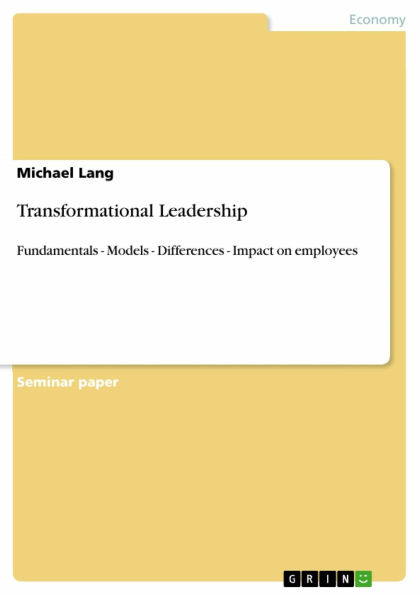Transformational Leadership: Fundamentals - Models - Differences - Impact on employees
Seminar paper from the year 2010 in the subject Business economics - Business Management, Corporate Governance, grade: 1,3, AKAD University of Applied Sciences Stuttgart, language: English, abstract: 'Transformational leadership is the buzzword in business today. It conveys passionate commitment. It inspires hope because it promises a purposeful way forward to a positive mind-changing and life-changing future.' (Lim, 2010) The author Lim (2010) emphasises in his article the popularity of transformational leadership in the world of the 21th century. According to Lim (2010) the economic and social environment is changing constantly with an increasing speed. Therefore many politics and business executives ask themselves how they should cope with the changed circumstances, such as globalisation and global poverty (Bass & Riggio, 2005, p. 224). From Burns's (2003) point of view transformational leadership gives answers to these most critical questions of the world. The transformational leadership model helps leaders to prepare themselves and their followers for the future. It is a process that changes and transforms people. It deals with emotions, values, ethics standards and long-term goals. Finally, it pushes the follower to the unexpected and creates a common vision (Northouse, 2009, p. 186). However, there arises the question what is transformational leadership really and why is it so popular in contrast to other types of leadership? In order to answer these questions chapter 2 defines the terms leadership, management and outlines the contrast between leaders and managers. Chapter 3 presents the main chapter of this assignment. It gives a brief overview of different leadership models and their characteristics in section 3.1. The following three sections deal with the transactional and transformational leadership model and their impact on behaviour and performance of employees. Moreover chapter 4 discusses the dvantages and disadvantages of transformational leadership theories. Finally chapter 5 summarizes the basic insights and gives a short perspective.
1119540338
Transformational Leadership: Fundamentals - Models - Differences - Impact on employees
Seminar paper from the year 2010 in the subject Business economics - Business Management, Corporate Governance, grade: 1,3, AKAD University of Applied Sciences Stuttgart, language: English, abstract: 'Transformational leadership is the buzzword in business today. It conveys passionate commitment. It inspires hope because it promises a purposeful way forward to a positive mind-changing and life-changing future.' (Lim, 2010) The author Lim (2010) emphasises in his article the popularity of transformational leadership in the world of the 21th century. According to Lim (2010) the economic and social environment is changing constantly with an increasing speed. Therefore many politics and business executives ask themselves how they should cope with the changed circumstances, such as globalisation and global poverty (Bass & Riggio, 2005, p. 224). From Burns's (2003) point of view transformational leadership gives answers to these most critical questions of the world. The transformational leadership model helps leaders to prepare themselves and their followers for the future. It is a process that changes and transforms people. It deals with emotions, values, ethics standards and long-term goals. Finally, it pushes the follower to the unexpected and creates a common vision (Northouse, 2009, p. 186). However, there arises the question what is transformational leadership really and why is it so popular in contrast to other types of leadership? In order to answer these questions chapter 2 defines the terms leadership, management and outlines the contrast between leaders and managers. Chapter 3 presents the main chapter of this assignment. It gives a brief overview of different leadership models and their characteristics in section 3.1. The following three sections deal with the transactional and transformational leadership model and their impact on behaviour and performance of employees. Moreover chapter 4 discusses the dvantages and disadvantages of transformational leadership theories. Finally chapter 5 summarizes the basic insights and gives a short perspective.
21.73
In Stock
5
1

Transformational Leadership: Fundamentals - Models - Differences - Impact on employees
28
Transformational Leadership: Fundamentals - Models - Differences - Impact on employees
28
21.73
In Stock

Product Details
| ISBN-13: | 9783640793396 |
|---|---|
| Publisher: | GRIN Verlag GmbH |
| Publication date: | 01/01/2011 |
| Sold by: | CIANDO |
| Format: | eBook |
| Pages: | 28 |
| File size: | 2 MB |
From the B&N Reads Blog
